Home > Highlighting JAPAN > Highlighting Japan OCTOBER 2012 > A Walk through Tokyo's Great Outdoors
Highlighting JAPAN
COVER STORY: TOKYO: NEW PERSPECTIVES
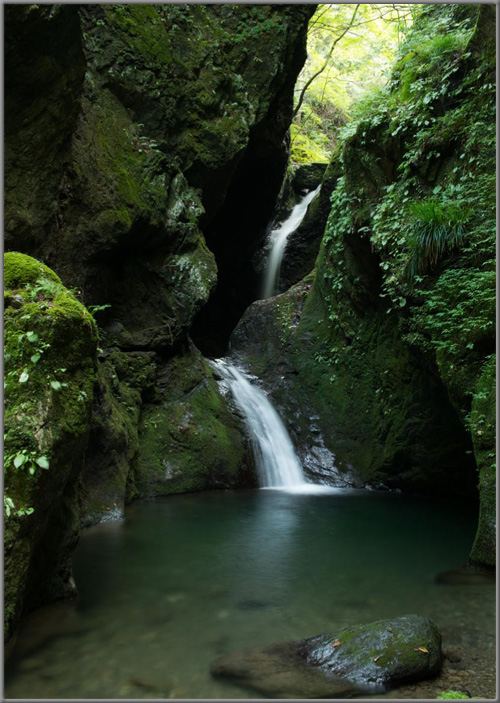
Caption: Nejire no taki in Okutama. This waterfall has around a 10-meter drop and is two-tiered with an upper and lower portion. Viewing it head on, the water flow looks as if it is spiraling down from left to right and then from right to left.
Credit: MASATOSHI SAKAMOTO
A Walk through Tokyo's Great Outdoors
Tokyo is not just a concrete jungle. Take a bit of a jaunt and one can experience the great outdoors, stunning scenery blessed with water and greenery. Tokyo is also home to world natural heritage sites where treasured natural environments still remain.
The Japan Journal's Osamu Sawaji reports.

A view of the gorge from Shidaraku-bashi
Credit: MASATOSHI SAKAMOTO
"This place really does not seem like Tokyo! I also visited here last week, and since it was such a great place, I brought three of my friends here today."
A woman in her sixties in hiking shoes and a backpack speaks cheerfully in front of the Nejire no taki waterfall that surges downstream. These four people got on a two-hour train ride on the JR Ome line from Shinjuku Station in Tokyo, got off at the end of the line at Okutama Station, and instead of getting in a car, walked on a trail for two and a half hours along the river to the waterfall.
There are two waterfalls close to Nejire no taki: Mitsugama no taki, a three-tiered waterfall with an 18-meter drop, and Otaki with a 23-meter drop. The Unazawa Santaki trail has been set up to lead to these waterfalls. Very close to this trail is a mountain stream, with beautiful mossy rocks. Here, people enjoy an activity called canyoning, which involves traveling in canyons using techniques such as climbing, scrambling and sliding.
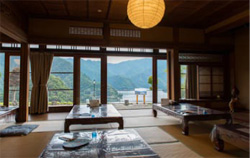
A sweeping view of Okutamako is visible from Aometachi Fudoson Yasumidokoro. The mountains are imbued with red foliage in the fall.
Credit: MASATOSHI SAKAMOTO
The Aometachi Fudoson Yasumidokoro, which is located just before the end of the Okutama Mukashimichi trail, is a rest stop that is also a renovated private residence built over 100 years ago. One can enjoy handmade soba noodles and rice cakes here, and have one's fill of the gorgeous views of the expansive Okutamako below.
"Not only the Japanese, but also tourists from Asia, Europe and the Americas take walks on these ancient paths. The other day, there was a woman who was here alone from Hong Kong and said she found the place on the Internet," says a male employee at Aometachi Fudoson Yasumidokoro. "There are a lot of people who say Okutama is a great place to commune quietly with nature. But Okutama does bustle with people in the fall because the foliage is beautiful then."
A sweeping view of Okutamako is visible from Aometachi Fudoson Yasumidokoro. The mountains are imbued with red foliage in the fall.
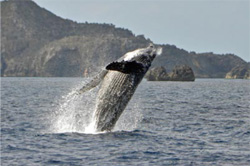
A humpback whale in mid-air. It is possible to see humpback whales from the Ogasawara Islands from the end of December to mid-May.
Credit: COURTESY OF MINISTRY OF THE ENVIRONMENT
The Ogasawara Islands, which consist of around thirty small and large islands in the Pacific Ocean, are said to be the farthest islands in Japan because of a decision not to build an airport from the standpoint of conserving the natural environment. The only way to get there is to take a 25-hour journey by boat from Tokyo, but the Ogasawara Islands are definitely worth taking the time to visit.
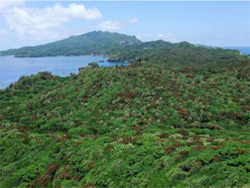
A beach on Minamijima. Landing on the uninhabited Minamijima is limited as a way to protect the environment. It is only possible to go ashore with tour companies that have been certified by the city of Tokyo and Ogasawara Village.
Credit: COURTESY OF MINISTRY OF THE ENVIRONMENT
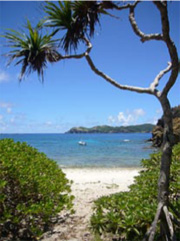
Overlooking Chibusayama from Hahajima Minamizaki. It takes two and a half hours by boat from Chichijima to Hahajima.
Credit: COURTESY OF OGASAWARA VILLAGE
The temperatures are mild on the islands, with the average temperature at 23°C, so it is possible to swim outdoors all year round. The best season for swimming is from May through November. There is one ship that sails to the Ogasawara Islands (Chichijima) every week or so. The only inhabited islands in the chain are Chichijima (around 2,000 residents) and Hahajima (around 500). Camping outdoors is prohibited, so it is necessary to make reservations for overnight accommodations.
A City of Slopes
In the section of a popular Tokyo magazine's annual reader survey asking where Tokyoites would most like to live, Kichijoji regularly takes the top spot. The area is popular with people living outside Tokyo and with visitors from overseas as well. Julian Ryall enjoys a stroll around town.
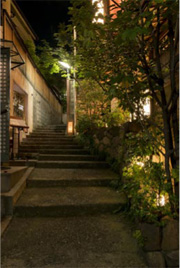
One can savor the ambience of traditional Japan by just taking a step onto an alleyway off of Kagurazaka.
Credit: MASATOSHI SAKAMOTO
There are a lot of slopes named Fujimizaka because Mount Fuji was viewable from the sites. There are around twenty Fujimizaka slopes in central Tokyo alone (out of these, there are two slopes from which Mount Fuji can still be seen today; Mount Fuji is around 100 kilometers from Tokyo).
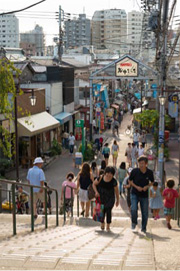
A view from Yuyake dandan just above Yanaka Ginza
Credit: MASATOSHI SAKAMOTO
Even today, there are traditional restaurants around Kagurazaka on elegant cobblestoned alleyways where one can enjoy geisha performances while dining.
There are several slopes in the Yanaka, Nezu and Sendagi areas (in Bunkyo Ward and Taito Ward) that have become popular recently and are reminiscent of the Edo period and the Meiji period (1869–1912). Of these, the slope (steps) Yuyake dandan (yuyake means sunset) is known to be a place where, literally, a beautiful sunset can be viewed. The shopping street Yanaka Ginza is at the foot of Yuyake dandan. It is a traditional shopping strip that frequently appears on TV and in magazines, and is lined with stores like confectionary stores, fishmongers and butchers. This is a great place to learn about the life of the masses in Japan.
© 2009 Cabinet Office, Government of Japan






